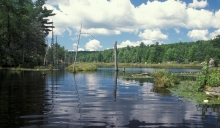You are here
Pitcher Plants as Models for Ecosystem Change

An innovative new study led by HF senior ecologist Aaron Ellison and Summer Research Program student Jennie Sirota was published today in the Proceedings of the National Academy of Sciences. The NSF-funded study investigated the factors that cause some lakes and ponds to shift from a clear, oxygen-rich state to an irreversible green sludge. Those green ponds have passed a critical threshold, called a tipping point. Until now, the mechanisms behind those tipping points were poorly understood.
Sirota and Ellison didn't conduct their tipping point experiments in lakes or ponds; they worked inside the tiny confines of carnivorous pitcher plants. On a smaller but scientifically comparable scale, these plants host complex aquatic environments and foodwebs that are strongly impacted by changes in nutrient levels.
According to reviewer and well-known limnologist Stephen Carpenter, "Every graduate student around the world working on tipping point indicators will start working through this model.”
Last summer, Sirota led the fieldwork and greenhouse experiment and helped analyze the data. In the fall, she co-wrote the paper with Ellison, HF post-doctoral fellow Ben Baiser, and UVM professor Nick Gotelli. "It was an amazing experience," she says. "Now I want to go to graduate school and do research in plant sciences."
- Read the National Science Foundation press release.
- Read the Harvard Gazette story.
- See photos and the original PNAS paper.
- Hear from Aaron Ellison on WAMC's Academic Minute.
- See Jennie Sirota's summer blog post from the field.
- VIDEO CLIP: Aaron Ellison describes how pitcher plants work.
Extract from "Invisible Nature - Colonising Plants" © Mona Lisa Production. All Rights Reserved.

